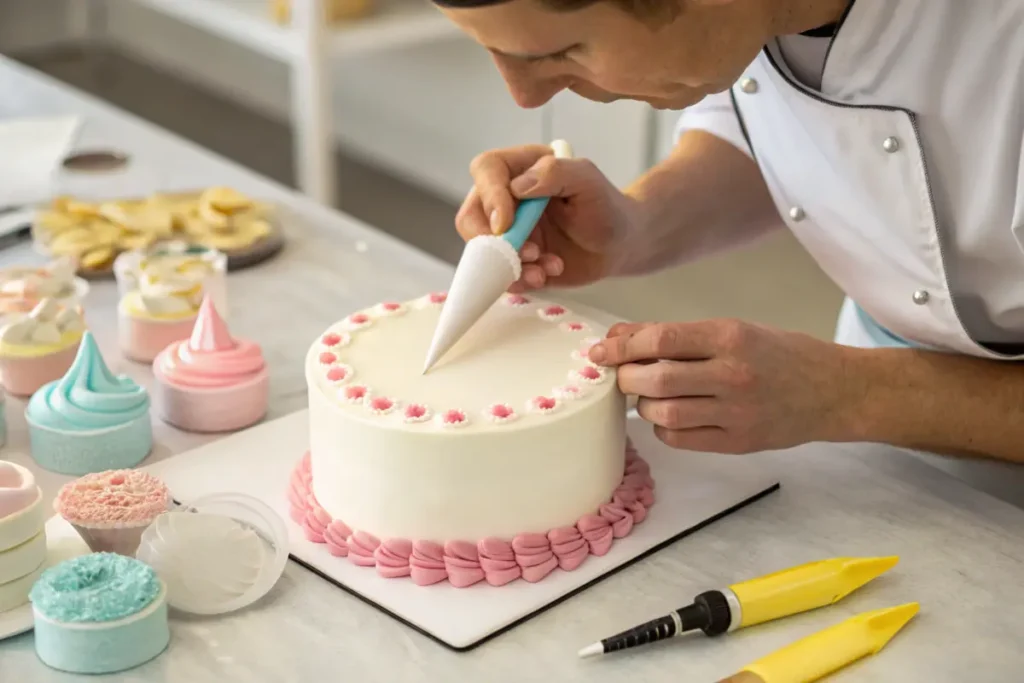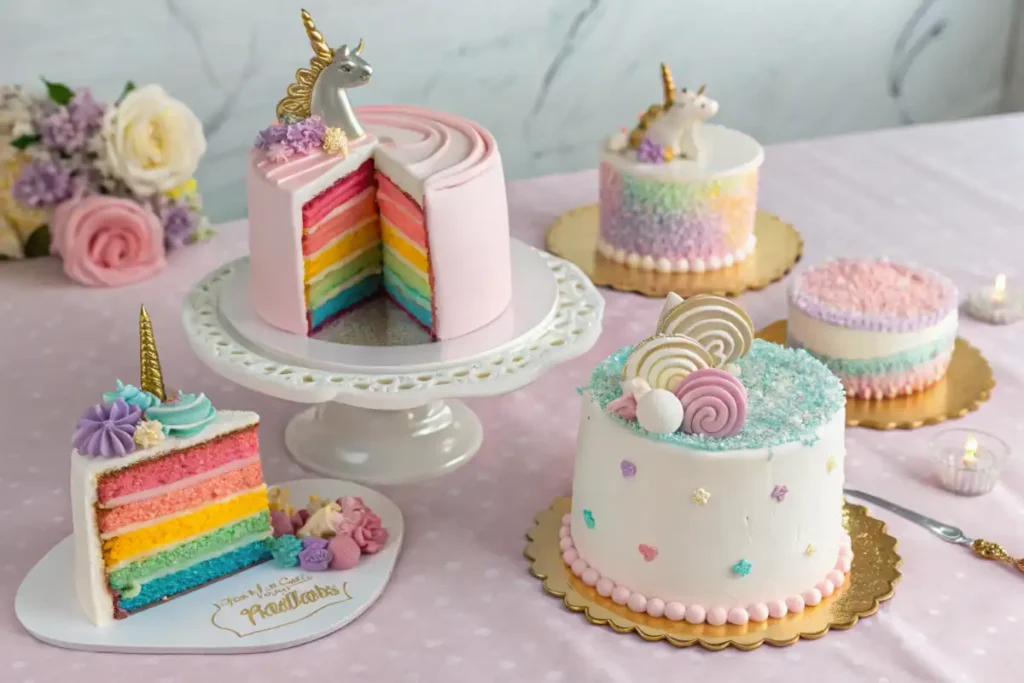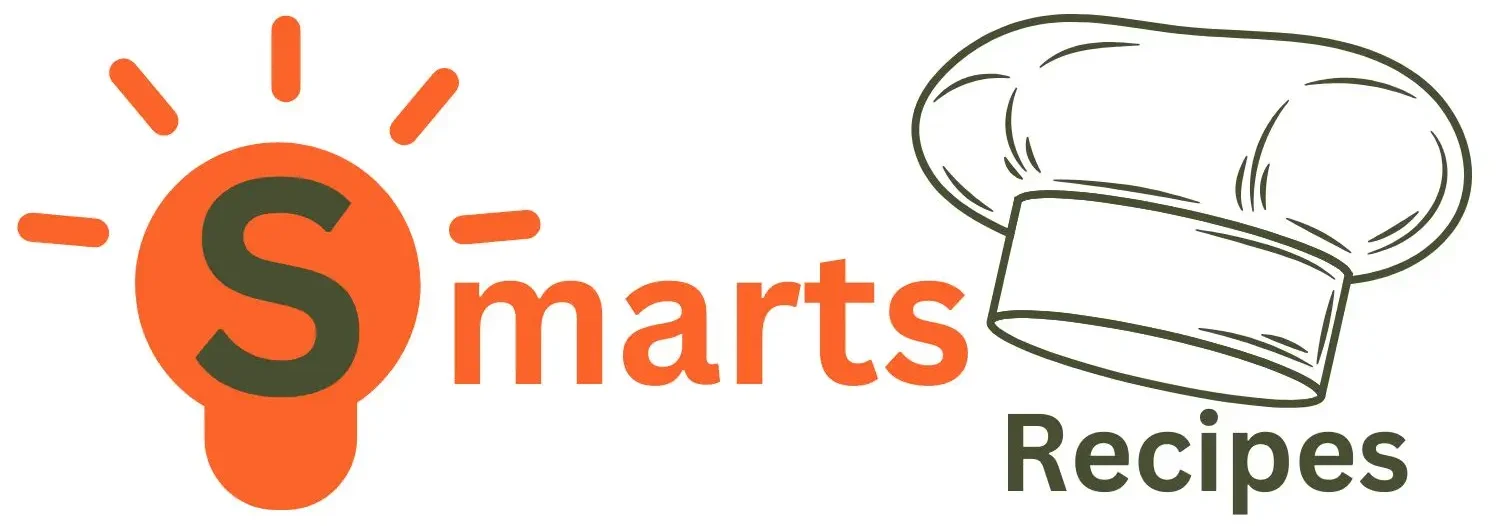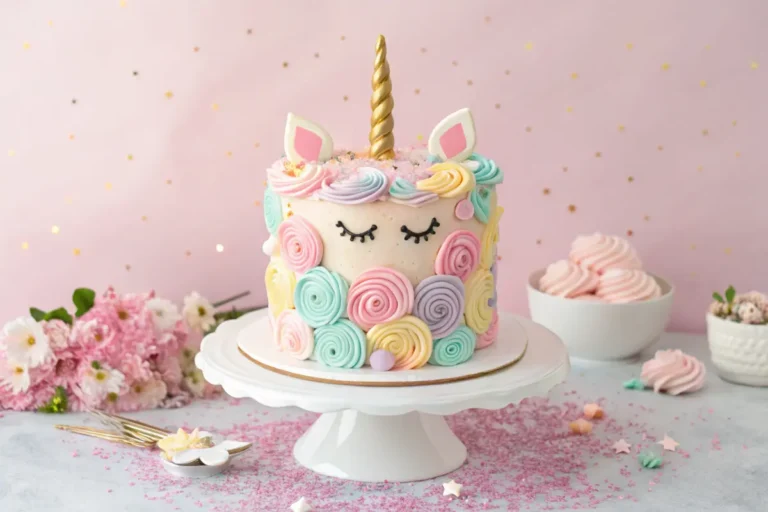Introduction: The Enchanting World of Unicorn Cakes
Unicorn cakes have captured the hearts of dessert enthusiasts worldwide, but have you ever wondered who invented the unicorn cake? . Altogether, they appeal to children and grown-ups alike, creating a delightful centerpiece for birthday parties, baby showers, and whenever you crave a fantastical twist. Initially, one might think these vibrant confections simply emerged from nowhere, but that assumption can be misleading.
Historically, unicorn-themed treats have existed in various forms, but today’s iconic design owes much to the rise of social media. Viral images of sparkling horns and flowing manes have turned these cakes into global sensations. A single photograph can amass thousands of likes, spreading the unicorn cake’s enchantment far and wide.
But who first imagined adding such mythical flair to a simple cake? In this article, we’ll explore who invented the unicorn cake by tracing its origins, evolution, and cultural significance. Whether you’re a baking enthusiast or simply a fan of all things magical, you’ll discover the inspiration behind this beloved dessert and find fresh ideas to create your own whimsical masterpiece.
This revised introduction includes the focus keyphrase “who invented the unicorn cake” naturally and strategically, while also increasing engagement and clarity.
1. The Origins of Unicorn Cakes
Early Mentions of Unicorn-Themed Desserts
Evidently, the concept of unicorn-themed desserts predates the modern era. In 1851, an English cookbook described a fanciful cake adorned with meringue and almonds shaped like a horn, an early nod to unicorn imagery. While lacking today’s pastel hues and intricate buttercream designs, these creations captured an air of enchantment. These historical experiments laid the groundwork for what we now recognize as unicorn cakes. Over time, and especially with the rise of social media, these desserts evolved into the glittering, multicolored masterpieces that enchant bakers and party-goers worldwide. But who invented the unicorn cake? That’s the true mystery.
The Modern Unicorn Cake Phenomenon
The modern unicorn cake—with its pastel hues, golden horn, and delicate buttercream mane—didn’t just appear out of thin air. Basically, it took shape in the mid-2010s, after social media platforms became fertile ground for eye-catching baking trends. Consequently, bright colors and whimsical themes gained momentum because photos of luscious swirls or glittery toppers stood out in crowded feeds. Indeed, the unicorn look captured hearts straightaway.
Additionally, the do-it-yourself (DIY) movement that blossomed around the same time encouraged home bakers to replicate professional-quality designs. Henceforth, everyone wanted a piece of the unicorn cake craze, from novices testing their first fondant horn to seasoned pastry chefs pushing their creative limits. However, the unicorn theme didn’t just stand for visual appeal—it symbolized the magic and wonder that many people sought in everyday life.
Similarly, the popularity of unicorns in fashion and popular culture drove more interest in the culinary scene. Merchandise, digital stickers, and rainbow-colored beverages all fueled a broader cultural obsession with fantasy. Subsequently, this enthusiasm spilled over into the kitchen. Thirdly, it’s worth noting that pastel aesthetics became a hallmark of this trend, as bakers found that soft pinks, blues, and yellows complemented the ethereal vibe. Certainly, once these cakes hit Instagram, there was no turning back.
Comparatively, other novelty cakes—like mermaid or galaxy cakes—did gain traction. Yet, the unicorn cake remained a chiefly prominent fixture because it combined simplicity (a single horn and a mane) with boundless customization options. Thus, professional bakers kept innovating, adding intricate piping, edible glitter, and unique flavor profiles. Concurrently, the public’s unquenchable thirst for magic and fairy-tale elements helped this dessert maintain its vibrant foothold in the market.
Jenna Rae Cakes and the Unicorn Cake Trend
Surprisingly, one bakery that played a pivotal role in catapulting the modern unicorn cake into the spotlight was Jenna Rae Cakes in Winnipeg, Canada. According to MASHED, Jenna Hutchinson, co-owner of the bakery, received a special request in 2016 for a birthday treat that was both whimsical and adorable. Subsequently, she designed a cake featuring dainty eyelashes, a fondant horn, and a flowing mane of pastel buttercream rosettes.
Afterward, the bakery snapped a photo and posted it to Instagram. Shortly, the image went viral, garnering likes and shares from cake enthusiasts worldwide. Furthermore, the design’s simplicity—a few well-placed buttercream swirls and a carefully sculpted horn—made it relatively easy for other bakers to replicate. Evidently, many home bakers and professionals eagerly jumped on the trend, posting their own versions online.
Consequently, the unicorn cake’s iconic features started popping up in wedding receptions, baby showers, and themed parties, whereas once they might have been relegated to children’s birthdays alone. Comparatively, few other cake designs have managed to maintain such a strong presence over the years. Notwithstanding minor variations—like adding metallic paint or sprinkle-laden edges—the core elements remain recognizable.
Finally, Jenna Rae Cakes helped crystallize a movement that transformed a simple fondant horn and colorful swirl into a global phenomenon. Hence, the next time you see a vivid pastel mane and a gleaming gold horn, you’ll know the culinary heritage reaches back further than you might imagine.
2. The Evolution of Cake Decorating
A Brief History of Cake Decorating
Before unicorn cakes captured imaginations, cake decorating had a rich history. Ancient cakes were plain, honey-sweetened breads, but the Renaissance introduced sugar paste and intricate designs for European aristocracy. French patisserie techniques and British fruitcakes with marzipan shaped the art, while modern refrigeration and food coloring enabled new creative possibilities. These advancements paved the way for elaborate fondant and buttercream designs, setting the stage for whimsical themes. Unicorn cakes, combining intricate aesthetics with playful charm, owe their evolution to this legacy of innovation. But who invented the unicorn cake? Its origins remain as enchanting as its design.
The Role of Social Media in Popularizing Cake Trends
Social media has revolutionized modern cake decorating, making platforms like Instagram and Pinterest essential for sharing and discovering trends. Through visually stunning posts, bakers who once had limited audiences can now showcase their creations globally, and unicorn cakes have become a standout phenomenon. Tutorials, color palettes, and piping hacks are just a tap away, empowering home bakers and professionals alike.
A single post of a vibrant unicorn cake can go viral, attracting thousands of likes and sparking widespread replication. Hashtags like #UnicornCake make it easy to track innovations, while user feedback fosters real-time creativity. Critics argue these trends sometimes prioritize style over substance, but social media creates an inclusive environment where ideas flourish.
The unicorn cake phenomenon, propelled by social platforms, reflects a universal longing for fun, color, and fantasy. This digital space not only spreads the magic of unicorn cakes but ensures their lasting influence on the culinary world. So, who invented the unicorn cake? Its story thrives in this global exchange of creativity.
3. Understanding the Unicorn Myth
The Mythical Origins of the Unicorn
Unicorns have captivated humanity for centuries, appearing in Mesopotamian art and ancient Greek texts as symbols of purity and majesty. With their spiraling horns and mythical powers, they were often depicted as rare and magical creatures. Over time, unicorns transitioned from medieval bestiaries, where they symbolized innocence, to popular culture as vibrant, whimsical icons. This evolution laid the foundation for modern unicorn-themed creations, including the beloved unicorn cake.
The question of who invented the unicorn cake ties to this enduring fascination, as bakers embrace the mythical creature’s pastel manes and glittering horns. Today, unicorn cakes embody imagination and enchantment, blending history with culinary artistry to create edible fantasies that captivate all ages.
The Unicorn’s Cultural Resurgence in Modern Times
Unicorns have seen a remarkable resurgence, from fashion to food, captivating both nostalgic adults and children alike. Social media amplified this trend, with bakers and artisans embracing the motif to create unicorn-themed treats like milkshakes, doughnuts, and, notably, the unicorn cake. This culinary masterpiece combines pastel palettes and whimsical designs, reflecting a universal need for positivity and fantasy. The question of who invented the unicorn cake highlights its evolution as a cultural icon. With its gentle and inclusive imagery, the unicorn cake embodies joy, making it a timeless celebration of creativity and enchantment in everyday life.
4. Crafting the Perfect Unicorn Cake
Essential Ingredients and Tools
Creating a standout unicorn cake starts with the right ingredients and tools. Use high-quality cake batter, buttercream frosting, and pastel gel food coloring to craft vibrant hues. Fondant is essential for shaping the signature horn and ears, while edible glitter and sprinkles add a magical touch. Tools like a turntable, offset spatula, and piping bags with star tips ensure smooth frosting and detailed designs. For success, assemble your cake layers carefully and use sturdy fondant shapes. Whether you’re inspired by who invented the unicorn cake or personal creativity, these essentials transform your dessert into a showstopper.
Step-by-Step Guide to Decorating
Ready to whip up your own enchanting unicorn cake? Before diving in, gather your ingredients and tools. Below is a detailed recipe to help you bake and assemble this mythical showstopper:

Ingredients for a 2-Layer Cake (8-inch round pans)
- 3 cups all-purpose flour
- 2 ½ teaspoons baking powder
- ½ teaspoon salt
- 1 cup unsalted butter (softened)
- 1 ½ cups granulated sugar
- 3 large eggs
- 1 cup milk
- 2 teaspoons vanilla extract
Buttercream Frosting
- 1 cup unsalted butter (softened)
- 4 cups powdered sugar
- 2-3 tablespoons milk (adjust for consistency)
- 1 teaspoon vanilla extract
- Gel-based food coloring (pastel pink, purple, teal, etc.)
Fondant Details
- 6-8 oz white fondant for the horn and ears
- Edible gold dust or gold paint
- Edible glitter (optional)
Step-by-Step Instructions
- Baking the Base
- Initially, preheat your oven to 350°F (175°C). Then, grease and line two 8-inch round cake pans.
- In a medium bowl, whisk together flour, baking powder, and salt. Set aside.
- In a separate bowl, cream butter and sugar until light and fluffy. Add eggs one at a time, beating well after each addition. Afterward, stir in the vanilla extract.
- Alternately, add the dry mixture and milk to the butter mixture, beginning and ending with the dry ingredients. Eventually, distribute the batter evenly between the prepared pans.
- Bake for 25-30 minutes, or until a toothpick inserted in the center comes out clean. Let the cakes cool.
- Preparing the Frosting
- Cream butter in a mixing bowl until smooth.
- Gradually add powdered sugar, milk, and vanilla extract. Beat until creamy.
- Divide the frosting into separate bowls and tint each with a different pastel color.
- Assembling the Cake
- Place the first layer on a turntable or serving plate. Spread a thin layer of frosting on top.
- Stack the second layer, then frost the entire cake, smoothing the sides with an offset spatula.
- Creating the Horn and Ears
- Roll the white fondant into a cone shape for the horn. Twist slightly for a spiral effect.
- Cut out two triangular ear shapes. Paint or dust with gold for shimmer. Let them firm up.
- Piping the Mane
- Fill piping bags with your colored frostings. Using star or rosette tips, pipe swirls to form the unicorn’s mane on top and down one side.
- Adding Final Details
- Insert the fondant horn on top and place the ears on either side.
- Draw or pipe closed eyes and add edible glitter. Presently, your unicorn cake is ready to dazzle!
Hence, enjoy your delightful creation, and consequently watch it bring smiles and gasps of wonder at any celebration.
5. Variations and Flavor Profiles
Popular Flavors for Unicorn Cakes

While classic vanilla often takes center stage, unicorn cakes can also be infused with a range of flavors. Albeit vanilla pairs perfectly with buttercream, it’s certainly not your only option. Comparatively, chocolate offers a richer profile and can be tinted with pastel colors if you use white chocolate ganache in the mix. Meanwhile, red velvet provides a striking contrast when you slice into the cake, unveiling a bold interior against whimsical frosting.
Additionally, funfetti—a sprinkle-laden vanilla-based batter—lends playfulness to your unicorn cake, reinforcing its magical aura. Likewise, if you’re feeling adventurous, flavors like carrot cake or coconut can provide unexpected twists. Regardless, the key is to maintain a lighthearted vibe through bright or soft pastel color palettes.
Frequently, the final choice hinges on personal preference. However, do consider the event type or your audience. For instance, children might prefer the sweet familiarity of vanilla, while adults might appreciate a dark chocolate or fruit-based filling. Occasionally, you might even mix flavors in a layered approach. Hence, you could do chocolate in one layer and vanilla in another, therefore broadening the cake’s appeal.
Undoubtedly, these varied flavors enhance the experience of slicing into a unicorn cake. Surprisingly, the combination of a colorful exterior and a flavorful interior can be downright showstopping. Essentially, it’s all about balancing aesthetic charm with tasty satisfaction. Afterward, guests will likely be buzzing about both the look and taste of your creation. Altogether, whether you’re a traditionalist or a risk-taker, there’s a flavor out there to transform your unicorn cake into an extraordinary treat.
Incorporating Unique Fillings and Frostings
Unquestionably, one of the best ways to elevate a unicorn cake is by experimenting with fillings and frostings. Interestingly, a simple raspberry jam spread between layers provides a tart contrast to sweet buttercream. Likewise, lemon curd infuses a zesty pop of flavor, particularly if your cake is vanilla-based. In contrast, chocolate ganache—rich and velvety—pairs well with pastel exteriors, though you should ensure it won’t alter your pastel color scheme too much.
Afterwards, consider the frosting style. Cream cheese frosting offers a tangy note that can cut through sugar-laden decorations. Equally, Swiss meringue buttercream brings a silky texture and a less-sweet flavor, letting pastel shades shine. Before committing to a single frosting, do a taste test to verify it aligns with your cake flavor.
Occasionally, bakers go all out with multi-layered fillings—think strawberry compote alternating with white chocolate mousse. Naturally, each layer can be tinted in a rainbow of soft hues, correspondingly amping up the unicorn vibe. However, keep in mind that more layers mean additional prep time and structural considerations, so ensure your cake’s foundation can handle the extra weight.
During final assembly, remember that your filling choice influences the cake’s texture and moisture level. Henceforth, a firmer filling like ganache is easier to handle when stacking layers. Nevertheless, if you adore a runny jam, stiffen your buttercream dam around the edges to prevent seepage. Clearly, each choice you make—from flavors to consistency—has a domino effect on the finished product.
Accordingly, by exploring unique fillings and innovative frostings, you’ll transform a basic unicorn cake into an unforgettable dessert that delights taste buds as much as it enchants the eyes.
6. Unicorn Cakes Around the World
Global Popularity and Cultural Adaptations
Unicorn cakes have evolved from their North American origins into global icons, captivating bakeries worldwide. Social media platforms like Instagram have propelled these creations into European, Asian, and Latin American shops, where local flavors like pandan, ube, and dulce de leche add regional flair. Despite variations, the golden horn, pastel mane, and flowing frosting remain universally enchanting. Bakers cater to diverse needs with vegan and gluten-free options, ensuring accessibility. The enduring question of who invented the unicorn cake highlights its rich cultural journey, uniting bakers and enthusiasts through creativity, fantasy, and shared inspiration across the globe.
Notable Bakeries Known for Unicorn Cakes
Several bakeries have gained fame for their exceptional unicorn cake designs, with Jenna Rae Cakes in Canada credited for pioneering the modern trend. Who invented the unicorn cake may remain a mystery, but bakeries like Kathleen Lange Cakes in the U.S. showcase masterclasses on sculpting the perfect horn and mane. Globally, bakeries offer unique twists, from hand-painted designs to collaborations with chocolatiers. These cakes, now a blank canvas for creativity, inspire a thriving community of bakers sharing techniques. Unicorn cakes epitomize culinary artistry, blending innovation and fantasy to spark joy and imagination worldwide.

